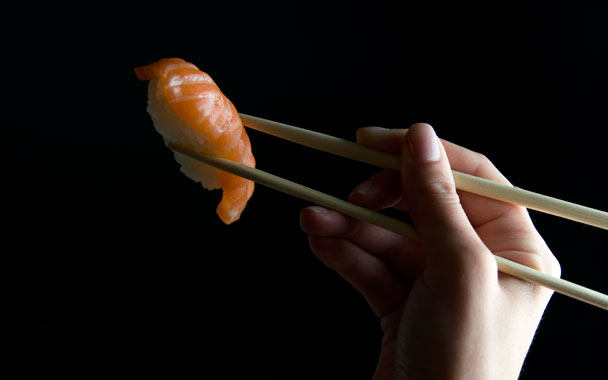Seafood chefs around the U.S. are paying a lot more attention to sustainability and the environment these days, but one group of fish-wielding chefs has yet to jump on the bandwagon: sushi chefs. Considering the vast quantities of tuna, salmon, shrimp, eel, and other creatures from the sea that Americans gobble down in the form of sushi, this is a major omission. What’s worse, the global sushi trade relies heavily on fishing and farming methods that damage ecosystems and leave particularly massive carbon footprints.
Activists and consumers are starting to take note. Last month, two New York City teenagers became minor celebrities when they exposed the false labeling of fish at Manhattan sushi restaurants for a science project. And just last week, Greenpeace activists exposed the sale of unlabeled Atlantic bluefin tuna at one of the London eateries of sushi superstar Nobu Matsuhisa—a problem because there is growing evidence that the fish are endangered. Melissa Kogut, executive director of the nonprofit Chefs Collaborative in Boston, talks with restaurateurs around the country to help them make more sustainable purchasing decisions, but she has yet to encounter sushi chefs who are proactive on the issue. “It’s crucial that more sushi industry folks have ocean-friendly seafood on their radar,” she told me.
While researching my book The Story of Sushi: An Unlikely Saga of Raw Fish and Rice, I found that one of the very few sushi operations that’s been ahead of the curve on the question of sustainability is a chain in the UK called Moshi Moshi. In Japanese the name means “hello?,” which is fitting since Moshi Moshi is, in a sense, giving sushi chefs everywhere a wake-up call. Headquartered in London, Moshi Moshi advertises an environmentally friendly philosophy, and runs several sushi bars where the menus feature a “Clear Conscience Set” (a combo platter composed of sustainable and locally produced ingredients). The managing director of Moshi Moshi is a woman named Caroline Bennett, whose own conscience became clouded back in 1998 when she discovered that bluefin tuna were in trouble. After investigating the plight of the bluefin, she decided simply to stop serving it.
Bennett started scrutinizing the other ingredients sold at Moshi Moshi, and the exercise changed the way she thought about the business. Rather than place all her orders through the international distribution system, in 2004 Bennett found a dayboat fisherman in nearby Cornwall who could supply her on a daily basis (more or less, depending on the weather) with high-quality local fish that weren’t endangered or industrially produced.
These fish weren’t necessarily typical sushi fish: They included wrasse, sole, mullet, and pollock. But Bennett says her chefs have found the variety, new flavors, and environmental message to be a bonus. Today Bennett is working with Greenpeace, the World Wildlife Fund, the Slow Food Movement, other local fishermen, and chefs around Europe to develop small-scale, local, sustainable alternatives for supplying seafood to restaurants. “The whole tradition of Japanese food,” Bennett told The Daily Telegraph recently, “is based on what is to hand and what can be found locally.”
Will Moshi Moshi’s wake-up call reach American shores? There is the first glimmer of an awakening. This spring a sushi restaurant opened in San Francisco with little fanfare but huge ambitions: to serve no seafood that hadn’t been rated as completely sustainable and ocean-friendly by the Monterey Bay Aquarium’s well-known Seafood Watch program. The restaurant is called Tataki Sushi & Sake Bar, and its staff includes not just chefs, waiters, and dishwashers, but also an official “sustainability guru”—advisor Casson Trenor, who is not a cook but a fisheries analyst.
Trenor told me that he wants to take sustainability much further than any purveyor of sushi has so far. That means some dramatic and difficult choices: “No unagi [eel], no hamachi [farmed Japanese yellowtail], no farmed salmon, no longlined fish, no bottom-trawled fish—nothing that leaves any scars on the face of the deep,” Trenor explained in an email. “Ranched bluefin is an offender as well.” Indeed, bluefin tuna are frequently labeled as “farmed,” but the vast majority aren’t farmed in the usual sense at all—they’re simply caught from the wild as juveniles and fattened in ranching pens, a practice that probably puts even more pressure on wild populations, not less.
Whether American sushi fans will choose restaurants that refuse to serve some of their usual treats remains to be seen. But the sad truth is that as fish populations and ecosystems come under increasing pressure, those treats are going to disappear anyway. Like Caroline Bennett at Moshi Moshi, Casson Trenor and Tataki are actually attempting, in a way, to redefine sushi by offering up interesting, tasty, and sustainable alternatives. The menus at Tataki will feature farmed amberjack from Hawaii and Australia; handline-caught local albacore; and instead of farmed salmon, closed-containment farmed arctic char. “We’re going to be an honest, eco-friendly sushi place,” Trenor says, “not just a greenwashed marketing ploy.”
It’s a noble sentiment, but it’s probably also a shrewd business strategy. Nowadays, a genuine commitment to the environment is one of the best marketing ploys in town—just look at the success of seafood advocates like Barton Seaver, the young former chef at the restaurant Hook in Washington, D.C., whose concern for sustainability has earned him a bucketful of awards and attention from the likes of Oprah. Sushi chefs in the U.S. would do well to take note.

